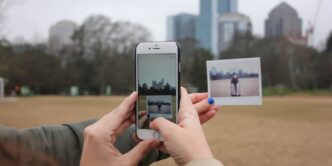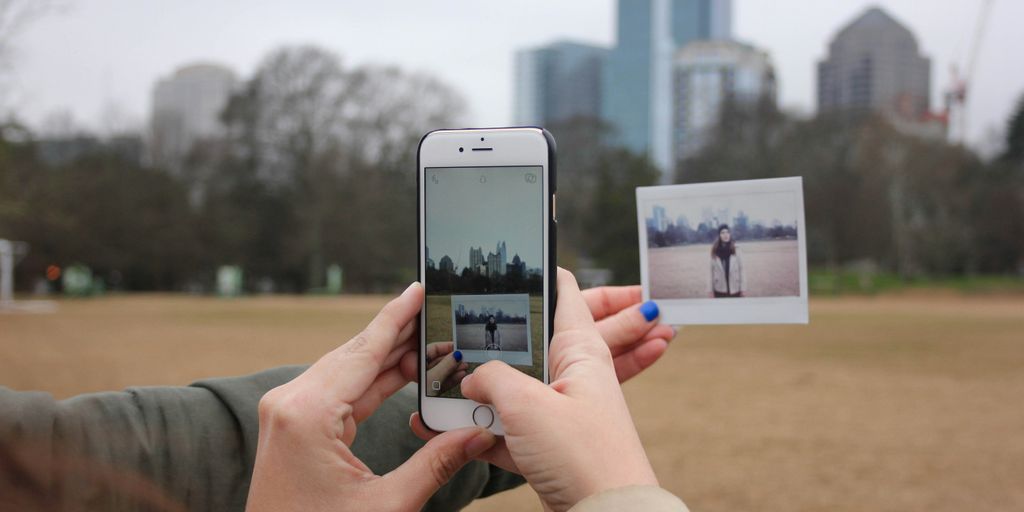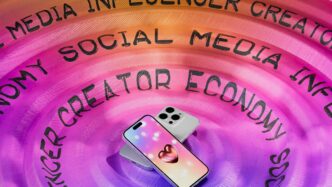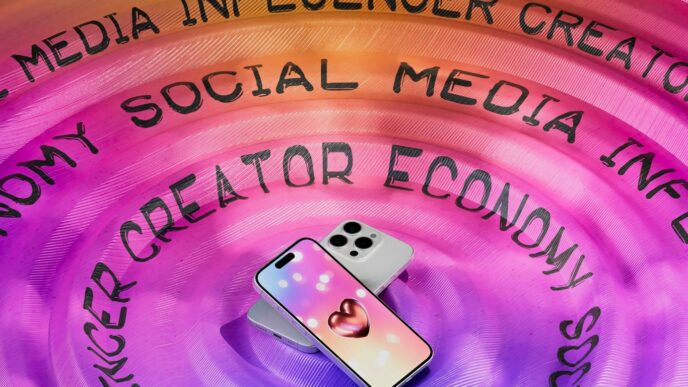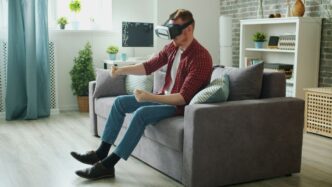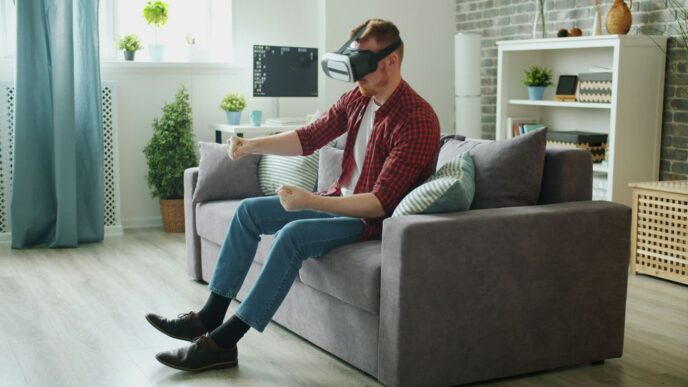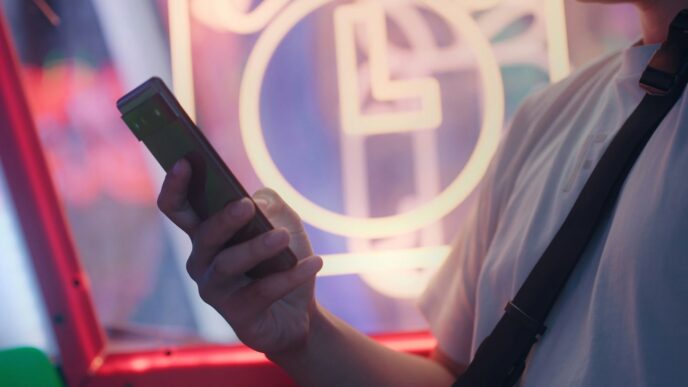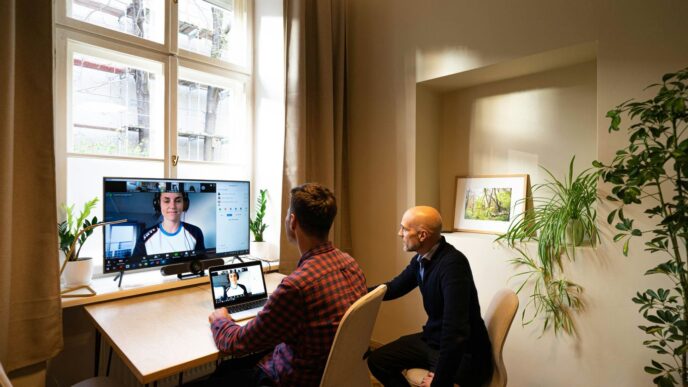Ever notice how social media just keeps changing? It seems like every other week there’s something new. Well, one of the biggest changes happening right now is all about augmented reality, or AR. This isn’t just about fun filters anymore; AR social media is totally shaking up how we connect, shop, and even experience events online. It’s making digital stuff feel more real, and that’s a pretty big deal for everyone, from regular users to big brands.
Key Takeaways
- AR social media is changing how people interact with digital content, making it more personal and engaging.
- Brands are using AR filters and lenses to connect with customers in new ways and even boost sales.
- Shopping on social media is getting a big upgrade with AR, letting people try things out virtually before buying.
- AR is a powerful tool for brands to launch products and create memorable experiences that people want to share.
- The future of AR in social media points to even more interactive and shared experiences, setting new standards for online connection.
The Evolution of AR in Social Media

Early Innovations in AR Social Media
Okay, so AR didn’t just pop up overnight. It’s been brewing for a while. Think back to the early days – clunky headsets and stuff. The Virtual Fixtures system was one of the first, trying to mix digital stuff with the real world. It was pretty basic, but it showed where things could go. Social media was still a baby back then, so AR was mostly in labs and research places. It’s wild to see how far it’s come.
Snapchat’s Pioneering AR Filters
Snapchat really changed the game. Remember when they dropped those face filters? Suddenly, everyone was a dog or had flower crowns. It was the first time most people actually used AR without even realizing it. Other platforms were quick to jump on the bandwagon, but Snapchat definitely set the trend. It made AR fun and accessible, not just some techy thing.
Mainstream Adoption of AR Features
After Snapchat, it was like a domino effect. Instagram, TikTok, even Facebook started adding AR features. Now, you can try on makeup, see what furniture looks like in your house, or play games all through social media. Brands are using it to sell stuff, too. It’s not just a gimmick anymore; it’s a real part of how we use social media every day. It’s pretty cool to see how AR has gone from a niche thing to something everyone uses.
AR Filters and Lenses on Social Media
AR filters and lenses have really changed how we interact on social media. It’s not just about posting a picture anymore; it’s about creating an experience. These tools let you transform your face, add virtual objects to your surroundings, and even play games, all within your favorite social apps. It’s wild how far things have come!
Brand Engagement Through AR Filters
Brands are catching on to the power of AR filters in a big way. Instead of just showing you an ad, they can let you try something on, see how it looks in your home, or even participate in a fun game. This is way more engaging than a static image or video. Brands utilizing AR filters on Instagram experience a 70% higher engagement rate than those using traditional filters, highlighting AR’s significant impact on brand engagement. Think about it: would you rather scroll past an ad for sunglasses, or virtually try them on and share a selfie with your friends? It’s a no-brainer.
Transforming User Experience with AR Lenses
AR lenses aren’t just for brands; they’re for everyone. They let you express yourself in new and creative ways. You can become a cartoon character, add silly hats, or even change your eye color. It’s all about having fun and sharing those experiences with your friends. Plus, these lenses are constantly evolving, with new ones popping up all the time. It keeps things fresh and exciting. The introduction of AR filters and lenses to social media is largely attributed to Snapchat with the launch of Lenses in 2015.
Driving Sales with Interactive AR
Okay, so AR is fun, but can it actually help brands sell stuff? Absolutely! Imagine being able to virtually try on makeup before you buy it, or see how a piece of furniture looks in your living room. That’s the power of interactive AR. It removes the guesswork from online shopping and makes it way more convenient. And when people are more confident in their purchases, they’re more likely to buy. Marketing featuring AR integration sees a 94% increase in sales conversions. It’s a win-win for brands and consumers.
AR Shopping on Social Media Platforms
AR is really changing how we shop online. I mean, think about it – you can practically try stuff on before you even buy it! It’s not just a gimmick; it’s making things easier and more fun. I saw this report from Snap and Ipsos that said something like 65% of people think AR makes shopping easier, and almost 80% are into using AR to check out products. That’s a big deal!
Enhancing the Online Shopping Journey with AR
Shopping online can be a gamble. Will that shirt actually fit? Will that makeup shade look good on me? AR is stepping in to fix that. By letting you virtually "try on" clothes or see how furniture looks in your living room, AR is helping to bridge the gap between seeing something online and actually owning it. It’s like having a personal stylist or interior designer right there with you. Plus, it’s way more engaging than just scrolling through pictures. This shopping experience is a game changer.
Virtual Try-Ons and Product Visualization
Okay, virtual try-ons are seriously cool. Imagine trying on different shades of lipstick without actually putting anything on your face – that’s AR for you. Or picturing a new couch in your apartment before you even click "add to cart." It’s not just about fun; it’s about making smarter buying decisions. No more guessing if that rug will clash with your walls! This tech is getting so good that you can see the texture of fabrics and the way light reflects off different surfaces. It’s pretty wild.
Seamless Purchase Paths with AR Social Media
What’s even better than trying something on virtually? Buying it without ever leaving the app! AR is making it possible to go from "I wonder if this looks good on me?" to "Ordered!" in just a few taps. Brands are teaming up with platforms like Instagram and Snapchat to let you try on stuff and then buy it right there. It cuts out a bunch of steps and makes the whole process way smoother. Plus, it’s a win-win for everyone – you get to shop without the hassle, and brands get to boost their sales. It’s all about making that social shopping experience as easy as possible.
AR Event and Brand Activations Using Social Media

Introducing a new product or hyping up an event can be tough without some buzz. AR is a cool tool to help with this, because it can make a product come alive even before it’s officially out. Let’s look at how brands are using AR to create memorable experiences.
Bringing Products to Life with AR
AR can really bring products to life. Think about it: instead of just seeing a picture, people can virtually interact with a product. This is especially useful for things like furniture or even makeup. It gives potential customers a feel for the product in their own space, making the decision to buy easier.
Scalable AR Experiences for Brand Campaigns
The great thing about AR for brand campaigns is how adaptable it is. You can easily tweak AR experiences for different markets, changing details as needed. Plus, AR fits right into both in-store promotions and online marketing, possibly making a product launch way more successful. For example, during the pandemic, San Fransisco Ballet used AR face filters to keep audiences engaged over the holidays.
Measuring Impact of AR Social Media Activations
So, how do you know if your AR social media activation is actually working? It’s all about picking the right metrics. Are you looking for more engagement, more sales, or better brand awareness? Once you know what you want to achieve, you can track the data and see if AR is helping you get there. For instance, Red Bull saw a 25% better performance with an AR promo video compared to their regular commercial. That’s a pretty good sign that AR is worth the investment.
Augmented Reality in Social Media Marketing and Advertising
AR is changing how brands and audiences connect. It’s all about creating experiences that are interactive and go beyond what normal marketing can do. It can make marketing campaigns more effective and help build stronger relationships between customers and brands.
Captivating Audiences with AR Experiences
AR can turn regular ads into something people actually want to interact with. Instead of just seeing a picture, people can try on clothes virtually or see how furniture looks in their home. This makes the marketing message more memorable. For example, Mini introduced an AR feature that let people see a real-size model of their car in their driveway. People spent an average of 28 seconds interacting with the feature, which led to a big increase in ad recall and brand favorability.
Boosting Engagement Metrics with AR Social Media
AR experiences on social media aren’t just cool; they can seriously boost your numbers. Think about it: people are more likely to share something they find fun and interactive.
- Increased dwell time: People spend more time interacting with AR content than with static ads.
- Higher share rates: Users love to share their AR experiences with friends.
- Improved brand recall: Memorable AR experiences stick with people longer.
Red Bull did an AR promo video that performed 25% better than their regular commercial. Also, an Augmented Reality game for Ladbrokes saw a 20% return rate from users who were activated via a social campaign.
Targeting Younger Demographics with AR
Younger people are all over social media, and they’re usually the first to try new tech. AR is no different. By using AR in your social media marketing, you can grab their attention and get them interested in your brand. Maybelline Thailand did a #SpreadGoodVibes campaign during the pandemic to keep people engaged. They used influencers and an AR filter on Facebook and Instagram, which helped them connect with their audience when everyone was stuck at home.
The Future of AR in Social Media
It’s interesting to think about where AR is headed in the social media world. It feels like we’re just scratching the surface of what’s possible. AR’s ability to merge the digital and physical worlds is more than just a cool feature; it’s changing how we connect. With so much noise online, AR offers a fresh way to grab attention and make things more interactive. People are more likely to buy from brands that use AR, and it builds loyalty. Let’s look at some specific areas.
Redefining Engagement Paradigms with AR
AR isn’t just a gimmick; it’s changing how we interact online. Think about it: instead of passively scrolling, you’re actively engaging with content in a whole new way. This shift is huge for brands trying to cut through the noise. AR experiences are more memorable, and that’s what really matters. It’s about creating moments that stick with people, not just fleeting impressions. For example, imagine using AR in education to bring history lessons to life, making learning more engaging and effective.
Interactive and Shareable AR Experiences
One of the biggest draws of AR is how shareable it is. People love creating and sharing fun, unique experiences with their friends. This creates a ripple effect, spreading brand awareness organically. The more interactive and engaging the experience, the more likely people are to share it. It’s like word-of-mouth marketing on steroids. Think about those Snapchat filters that went viral – that’s the power of shareable AR.
Shaping New Standards for Audience Connection
AR is setting a new bar for how brands connect with their audiences. It’s not enough to just broadcast messages; you need to create experiences that people want to be a part of. AR allows for a deeper, more personal connection. It’s about building relationships, not just selling products. This shift requires a new way of thinking about marketing and advertising. It’s about creating value for the audience, not just pushing products. The future of social media is all about creating these kinds of meaningful connections.
Wrapping Things Up
So, what does all this mean? Basically, AR is changing how we use social media. It’s not just about looking at pictures anymore. Now, we can try on clothes, play games, and see products in our own homes, all through our phones. This makes everything more fun and personal. Brands are really getting into this too, because it helps them connect with people in new ways. It seems like AR is here to stay, and it’s only going to get bigger on social media. It’s pretty cool to think about what’s next.
Frequently Asked Questions
How do brands use AR filters and lenses on social media?
AR filters and lenses add digital stuff onto what you see through your phone camera in real-time. Think of it like putting a virtual hat on your head or changing your background to a jungle. Brands use these to make fun, interactive ads, like letting you try on virtual clothes or play a game with their product. It makes their ads more engaging than just a picture or video.
How does AR on social media help boost sales?
AR helps brands sell more by letting customers “try on” or see products in their own space before buying. For example, you can see how a new couch looks in your living room or how a pair of glasses looks on your face. This makes people feel more sure about buying, which leads to more sales.
How is AR used in live streaming on social media?
AR is changing live streams by letting broadcasters add cool digital effects, face filters, and backgrounds as they stream. Brands use this to show off products in a fun way, like having a virtual try-on event during a live show. It makes the stream more exciting and interactive for viewers.
What are the future trends for AR in social media?
The future of AR in social media looks super exciting! We’ll see even more realistic filters, virtual shopping experiences that feel like real life, and ways to buy things instantly while you’re browsing. Content will also become more personalized, showing you things based on what you like, and live events will be much more interactive.
What are the best AR advertising strategies for social media?
To use AR well in your social media ads, you should create fun, interactive filters that people want to share. Work with popular social media stars to show off your AR features. Make games out of your AR experiences to get more people to join in. Also, use information about your customers to make AR content that they’ll really care about.
How has AR changed social media over time?
AR has grown a lot since Snapchat first launched its Lenses in 2015, letting people put fun effects on their faces. This made other social media apps like Instagram and TikTok add similar features. Now, AR is used for everything from trying on clothes virtually to seeing how furniture looks in your home, making social media much more interactive and personal.

